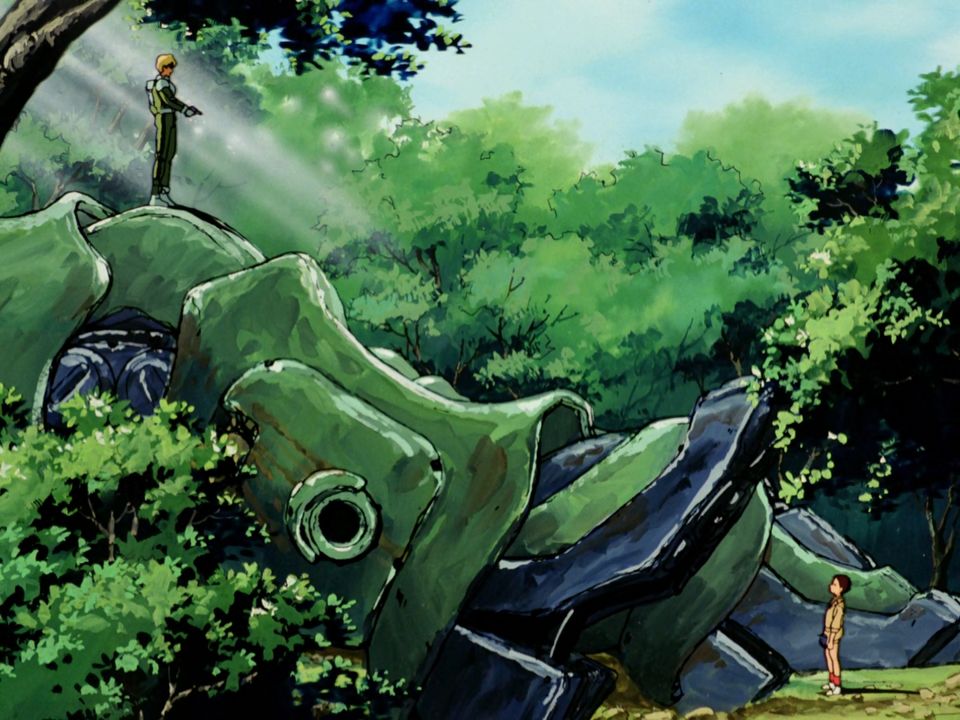[Week 2] Mobile Suit Gundam 0080: War In The Pocket (1989 OVA)

For the film club I do with friends, I'm picking a series of selections from the Mobile Suit Gundam franchise. Because not all of us are anime buffs, I figured I'd write some short intros for each thing I plan to have us watch, to provide a bit of context and explanation. The intros got a bit longer than I'd anticipated (probably because I was procrastinating working on another thing I should have been working on instead). Since I ended up being really happy with what I wrote, I thought I'd share them with a wider audience here on the blog.
Week 0 | Week 1 | Week 2 | Week 3 | Week 4 | Week 5
Movie club took a week off last week, as I was on vacation. This week, we watched the first half of Mobile Suit Gundam 0080: War in the Pocket, a six part Original Video Animation, or "OVA", directed by Fumihiko Takayama and released as a series of six monthly VHS tapes in 1989.
Line Go Up
During the mid 1980s, real estate and stock prices soared in Japan, heralding a new age of economic prosperity. This was definitely not indicative of a problem, and those prices were totally going to keep going up forever, don't even worry about it.
At the same time, the rise in animated shows targeting young adults (like Gundam), had driven the emergence of the otaku. Initially a pejorative term deriding geeky, out of touch and socially inept fans of anime and manga, otaku would later enter common use as more a neutral description for the nascent subculture of obsessive fans. Otaku were known for cultivating large collections of anime, manga, and related merchandise (like Gunpla plastic models).
The otaku phenomenon, in combination with the bubble economy, created a market of eager enthusiasts with cash to spend and collections to build. VHS releases of anime sold at exorbitant prices. Release companies had initially expected their primary market for anime on VHS to be rental shops, not consumers, so they were priced as specialty items, sometimes up to $75 for a tape featuring two or three episodes. But studios had underestimated the deep pockets and deeper enthusiasm of otaku, who jumped at the chance to expand their collections, whatever the price.
So home video was an even more profitable market than studios had expected. Home video release companies joined toy manufacturers as major investors in anime production. With demand for new content seeming endless, and only so many time slots on television, studios began to produce content specifically for the home video market: the OVA.
A realization about VeggieTales
While the term “direct to video” in English-speaking countries tends to imply low budget or quality, that's not the connotation with OVA releases. If anything, the OVA was a prestige format. Releases tended to have a higher budget per episode than similar televised series, and weren't subject to many of the same production constraints, length restrictions, or censorship requirements. For this reason, OVA series were sometimes more violent or "adult" than televised shows, although I don't think that applies to War in the Pocket.
Like this week's selection, many popular OVA were spin-offs or adaptations of existing animated works. But there were also many serialized OVAs featuring original or new-to-animation series, like "Bubblegum Crisis", "Oh My Goddess", and "Battle Angel Alita".
It's interesting that the United States didn't see a corresponding boom in direct-to-video animation series at the same time. But as I was pondering this I realized that there was a similar phenomenon happening, albeit on a smaller scale, in Christian bookstores and mail order catalogs. VeggieTales comes to mind: that series began in 1993 via single-episode VHS tapes sold mainly through specialized niche retail channels. A glance at Wikipedia's List of animated direct-to-video series shows dozens of Japanese entries of varying genres and styles, but only seven American entries, three of which are for the Christian bookstore market. But that's definitely not an exhaustive list. My church basement had a bookcase full of them that we could borrow.
All this time I was thinking that my first time watching an OVA series had been "Tenchi Muyo". That was a bizarrely risqué space opera that aired in 2000 on Cartoon Network's weekday afternoon Toonami programming block, albeit in censored form, with bikinis painted over nude scenes. But it turns out my real first OVA was probably back in second grade at Our Lady of Victories elementary school, where we were shown “The Day The Sun Danced: The True Story of Fatima” from the "Saints and Heroes" VHS series. I don't remember how the nude scenes in that were handled.
Line Go Down
After the burst of the asset pricing bubble, Japan entered its “lost decade” of economic stagnation. The realm of pricey direct-to-video animation saw many casualties, and the home video market became a less viable platform for launching new properties, or even spin-offs.
By the 2000s, the OVA format still existed, but not primarily as a venue for serialized content. The typical OVA at this point would be a one-off piece of promotional bonus content relating to an existing series. For example, a 12 episode television series might offer a 13th episode as a DVD-only extra. These days, with physical home video releases no longer as popular as they were, promotional bonus content is more often released online, and referred to as “ONA” (Original Net Animation).
That said, although home video releases are less widely popular, die-hard otaku have endured in their willingness to pay absurd prices for DVD or Blu-ray. As a result, anime on home video is still really expensive in Japan. The most recent Gundam release in Japan, Volume 4 of "Mobile Suit Gundam: The Witch From Mercury," has three half hour episodes on it and it's priced at around $33 on DVD or $54 on Blu-ray.
Mobile Suit Gundam 0080: War in the Pocket
Following the success of the Mobile Suit Gundam film trilogy in 1981, Gundam's creator Yoshiyuki Tomino had written two further TV series chronicling the story of ongoing tensions between Earth and its colonies. In these stories, original protagonist Amuro took a back seat and left the Gundam piloting to a new generation of sad children. In the 1988 film "Char's Counterattack", a 29-year old Amuro finally returned to the spotlight to settle things once and for all with his old enemy Char.
With that rivalry suitably culminated, Gundam marked its tenth anniversary in 1989 with a bit of a deviation. Mobile Suit Gundam 0080: War in the Pocket was the first Gundam OVA, the first Gundam project without Tomino's direct involvement, and the first to revisit the One Year War seen in First Gundam, rather than depicting its aftermath. Eschewing the grand melodramatic space opera of First Gundam, War in the Pocket tells a side story about children far away from the front lines.
War in the Pocket proved popular, and led to many other Gundam OVA and ONA series. Revisiting the One Year War became something of a popular OVA theme. Another One Year War "side story" OVA, "Mobile Suit Gundam: the 08th MS Team", was actually the first Gundam series I ever got into. Given how much I loved 08th, I'm excited to check out War in the Pocket, as the two are often cited alongside one another as Gundam franchise high points.
Each episode is about 27 minutes, and we’ll watch episodes 1-3 this week. The series isn’t actually available streaming anywhere right now, so we can watch my copy, which has both the original Japanese audio and a 1999 English dub [sorry to the blog reading audience, you're on your own here]. Let’s talk at 9.
I really liked the first three episodes of War in the Pocket. I wasn't a huge fan of some of the human character designs, particularly for the main child character, but the overall the animation quality was pretty stellar, with some really tense and frantic mech battles and a lot of really great, fluid character animation. One example that stood out to me was the end of the second episode when Al clambers onto the back of a truck. I love a good clamber animation. The members of the movie club who weren't into the First Gundam movie were a bit more positive on this, but we were still pretty polarized. Among those of us who were positively engaged, we're all pretty worried for how it's gonna turn out. Episode three ends on quite a cliffhanger.

Member discussion